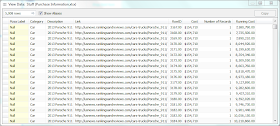Sometimes when you're working with data, there is a need to compare datasets that don't really have anything in common. This issue came up with my Sports Viz Show Me The Money: I had a dataset that contained the top 100 earning athletes in 2013 and I wanted to show what their pay could buy for them at an individual item level with out creating an unnecessary Cartesian product.
Athlete data: a single row per athlete
As Gru would say: Light bulb! If I create a data set containing a row for each purchasable item repeated the maximum amount of times it would appear (aka the number of times the top earning athlete, in this case Tiger Woods, would be able to purchase it), then I could write a calculated field that blended the two sources and did my filtering for me.
Stuff to buy data: note there is no column mentioning athlete
Doing this gave me two data sets: one that was 100 rows deep and the other just over 5,000 rows deep.
Next, after bringing in both data sets into Tableau, I created a cross dataset calculated field on the 'Stuff to Purchase' dataset that would allow me to filter out when the number of items exceeded the athletes pay.
running_sum(sum([Cost]))<=sum([Forbes 100 Athletes].[Pay $])
This way when I add the purchase able items at a data level, it will continue to referenced the accumulated value of the purchases and restrict them to only total that is less than the salary of the specified athlete.
Finally, I added
- RowID into the details
- 'How Many' true false filter to the filter section
- IMPORTANT: Change the 'Compute Using' to use RowID
- Add the purchase category and item to the filter section
- Added the object's description to shape
- Filtered it for the specified athlete (from the secondary source).
- This ultimately ended up being a quick filter that allowed me to select different athletes
Now I had my sheet that showed each of the items that the person could buy.
If I had joined them ahead of time, I would have had a Cartesian product of over 160,000 rows! This not only saved me data space, but also cut down on the data prep I needed to get dashboard built.
So the answer all along (to the question that was never asked) was yes, it will blend...even if there are no common dimensions. Let me know if you have any other questions and feel free to comment. Thank you!
Thanks for following along!
Nelson




I read testimonies and reviews about him so I contacted him immediately, explained my problems to him. Same day , he casted a spell for me and assured me for 2 days that my husband will return to me and to my greatest surprise the third day my husband came knocking on my door and begged for forgiveness. I am so happy that my love is back again and not only that, we are about to get married again, he proposed. I wouldn't stop talking about him. Contact him today if you need his help via email: emutemple@gmail.com and you will see that your problem will be solved without any delay. Website: https://emutemple.wordpress.com/ whatsapp number +2347012841542
ReplyDelete